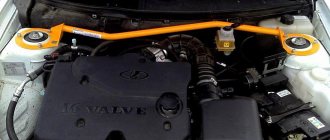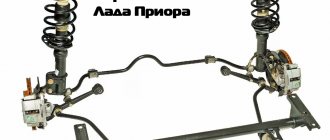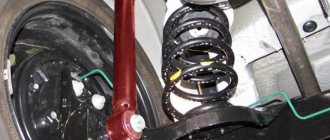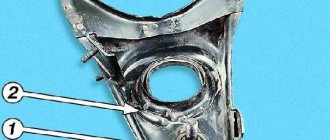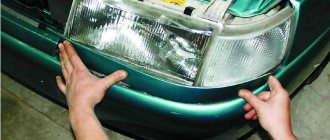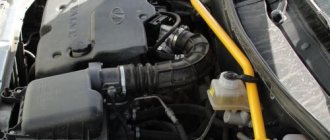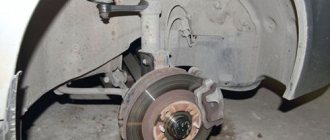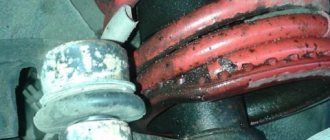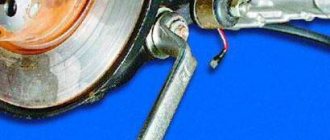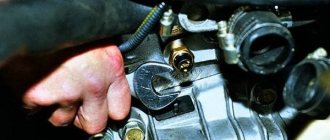Today, many car tuning elements have appeared on the shelves of car dealerships. These include spacers, stretchers, stands and much more. But here a logical question arises: do car enthusiasts themselves know what all these parts are used for? For some, this is a reason to brag to friends, while others are not even aware of their purpose. So, today I will tell you what a front strut strut is, I will highlight its types, purpose, positive and negative aspects, and I will also share with you the procedure for installing the strut.
Looking under the hood of the car, you can see a yellow tube connecting the upper supports of the body pillars. This is the detail we need. So, we can say that the strut brace is a car tuning that is being actively adopted from sports cars to ordinary ones. They are made from steel or aluminum. There are two types of such elements: adjustable and unregulated. Spacers of the first type should be installed on machines with broken geometry. Alas, in my opinion, it cannot provide the body with the necessary rigidity.
Therefore, in my opinion, a non-adjustable device is a better option compared to a non-adjustable one. Why? Because the non-adjustable one during its manufacture is welded in a jig, which has clearly established dimensions of the holes for fastening. So when choosing such a part based on this criterion, I advise you to choose a non-adjustable one. 2. According to the type of fastening, the parts come in 2-point and 3-point fastenings. For me personally, the last option is both more convenient and better in principle.
This type of spacers is attached, unlike 2-point mounts, both to the cups and to the body, while 2-point braces are attached only to the cups. This sometimes requires additional drilling of a hole. This is done to install the front strut, but we will talk about this later. As for the choice of front strut struts, I can say that studying the intricacies of the car is of great importance here.
For example, is there air conditioning or an electronic gas pedal. Moments like these are very influential. So why do you need a front strut brace? Let's talk about this now. The fact is that the main task of this part is to improve the car’s handling by increasing the angular rigidity of the body. Also, the front strut brace helps make the steering more responsive, i.e. capable of driving around an unexpected obstacle at lightning speed.
Of course, do not forget that installing this part will make your car more stable on the track, and will also significantly reduce the transfer of dimensions of the car body, so it will not “twist” when cornering.
Installation of struts and vehicle behavior
You can install the front strut strut either at a service center or yourself. On my own behalf, I will say that you will not have any problems during the personal installation process.
To do this you should do:
- Place the vehicle on a level surface;
- Unscrew all the nuts on the glass, use a 13mm wrench to help;
- Next, we install the part itself: fasten it to the mounting rods of the front shock absorber struts. Remember, the element being installed must attach to the rods without any problems;
- if you are installing a 3-point mounting spacer, drill an additional hole;
- tighten the nuts;
- If you are working with an adjustable part, you should adjust it at the end of the work.
Thus, after installing, we received:
- reduced vehicle response to the track;
- improved machine control;
- when driving on uneven areas, the trajectory of movement is observed;
- the life of the front suspension units has been increased.
Now we have installed the required part, so now let's talk about the car's reaction to this installation. Let's say you've been driving on uneven or unpaved roads. Here the front strut struts did their job - they absorbed the shock that the wheels receive when driving on such roads. The fact is that the force of these blows is directly proportional to the driving speed. Higher speed means stronger impacts.
The part absorbs these impacts and, at the same time, does not have a negative effect on the levers. Or here’s another situation: driving around corners. With the installation of the element, the car reacts faster to steering wheel turns. In addition, the turn can now be completed at greater speed. If you previously, for example, drove at a speed of 55 km/h, now you can cover the same distance at 75-80 km/h.
It turns out that when turning, all the weight and forces of the car are concentrated on one side, and the trajectory of movement shifts. By installing the spacers, the force of the machine spreads through them, resulting in the struts and lower arms being stabilized. I can give another example for comparison. If, before installation, some of the impact goes to the chassis, damaging the base of the wheels and the lower part of the arms, then after installing the part, both sides of the impact will be neutralized.
How to install?
After purchasing the part, you can install it yourself with your own hands.
It is very important that the car is parked on a level surface, otherwise the non-adjustable strut will not go into place, and the adjustable strut will not be installed correctly.
Step 1: Open the hood and unscrew all the nuts on the strut cups
Step 2: Install the spacer. The part should easily snap into place, the holes should align with the studs. If this does not happen, then either the car is not on a level surface, or it is time for it to go for a wheel alignment.
Step 3: If no difficulties arise, install the washers above the spacer and, without overtightening, tighten the nuts. If the stretch is adjustable, now is the time to adjust it.
Ready. We enjoy the result!
Advantages and disadvantages
Now let's look at the advantages and disadvantages of the mechanisms we are studying.
The advantages of front strut braces include:
- the load on the body decreases, which means it is less deformed;
- provides the driver with confident driving;
- reducing the likelihood of body cracks;
- possibility of self-installation.
As you can see, such parts have many advantages, however, like any working element, they also have disadvantages. Namely:
- high cost of both the element itself and its installation;
- if you hit the side, both racks will be faulty;
- the part creates discomfort when checking and adding brake fluid;
- Frequent replacement of two-point elements, because the front struts are deformed due to the uneven load on them.
So, thanks to my article, you became familiar with the front strut struts and their types, learned about their installation and the behavior of the vehicle after this procedure. In addition, we looked at the pros and cons of such parts. Many, of course, are skeptical about spacers, but I assure you that all these prejudices are formed only from ignorance about the advantages of using such parts.
In general, before you start work, you should decide whether you actually need sharpness in the car’s steering, analyze your driving style and decide whether it’s worth it or not.
If yes, my article will come in handy. After all, it is aimed at fully familiarizing the amateur with spacers. Successful work and safe travel!
Manufacturers and prices
In fact, the cost of extensions for front struts suitable for a VAZ 2114 car may vary depending on many factors.
Serious differences in price may arise due to the materials used and the manufacturers of these elements. On average, you can purchase a structure for a price ranging from 800 to 3000 rubles. The difference, as you can see, is significant.
Therefore, we suggest that you familiarize yourself with the most attractive options in terms of reliability and price, ideally suited to the design features of the body and pillars of the VAZ 2114.
Video “Stretching the front struts”
The recording shows how the process of stretching the front struts occurs.
Let's talk today about one very popular tuning element - the front strut brace, and find out why it is needed, what types there are, what are the advantages of using it and whether it can cause harm to the car.
You know very well that a car body is not a solid structure - it is a connection of individual elements by welding or screwing. From this we can conclude that the joints are weak parts of the body.
To make it easier for you to understand, let's use a chair as an example. Over time it becomes loose. And if you look at why, you can see that the connection points have weakened. The same thing happens with a car. And its weakest part, which is most deformed, is the front.
Such changes in the body structure lead to the fact that the car ceases to be stable when moving. When you are driving straight and on a flat road, you may not notice it. But as soon as you take a turn or drive onto a bumpy section of the road, you will feel all the “delights” of a deformed body.
And if you drive at high speeds and want to negotiate a corner, the car may pull so hard that you might go off the road - and that's the best case scenario.
So, the front strut spacers are installed in order to prevent front end deformation.
Installation
Installing front strut struts on your VAZ 2114 yourself will not be difficult. This procedure does not require any special skills, so you can safely go to your own garage and get to work.
- Remove the screws and washers from the shock absorber struts.
- If your car has a motion sensor on the struts, it will also need to be removed. But be sure to remember the position in which it was at the time of dismantling.
- Now secure the mounting bracket with the sensor directly under the plate. This must be done in such a way that the sensor is in its position before removal.
- The front strut extension is placed on the studs. The same work is done on both sides.
- The bolts are secured properly. Be sure to make sure the fasteners are properly tightened. In this matter, reliability plays a huge role. Therefore, it will not be superfluous to additionally verify the quality of the bolts used.
Types of spacers
The front strut struts are solid
and
adjustable
. It is better to give preference to solid structures - they are stiffer. But it may happen that not a single solid spacer will fit your model. Then there is no choice left, install an adjustable one.
The spacers are also divided into two
and
three-point
.
The first are mounted on the glasses, and for the second it is necessary to make an additional hole in the front part of the engine compartment.
Human factor (feelings before and after installation of the stretcher)
At low speeds and maneuvers, changes in sensations are practically reduced to zero, and this is also, of course, elementary physics, since the ability of the forces influencing the power points in this case is minimal due to the uniform and moderate influence. At higher speeds and maneuvering, the car rolls less when turning, the steering is more clearly responsive and, accordingly, the overall impression is that the car has become more reliable, strong and composed.
Now we can only hope that this article will help you with choosing the right decision regarding whether to install a spacer
to your car.
Very often, for those who like to drive a VAZ, you can see a spacer under the hood, usually yellow. Attitudes towards such modifications are quite varied. Some say that this is a very necessary thing, others say that such a spacer does more harm than good. So, in this article I want to list all the pros and cons of stretching the front struts. And also how to install a spacer on a VAZ 2110 with your own hands.
- The car behaves more stable at high speeds when cornering.
- Road unevenness causes less deformation of the car body.
- Reducing extraneous noise and crackling of the interior trim.
- Steering wheel vibration becomes less.
- The body becomes more rigid.
- Beneficial effect on front suspension parts.
There is no evidence of these disadvantages, well, at least not known to me, so it’s up to you whether to believe them or not. There is an opinion that in an accident, namely in a side impact, not only the side of the impact will suffer, but also the other side (it will bend the bowl, the stand). You say, exactly, this will happen with the help of a spacer, but these spacers have a hole in the center, through which, during an impact, the spacer bends and it does not transfer the blow to the other side. Another legend says that during a frontal impact, the engine is carried into the cabin due to the strut. Honestly, it seems to me that this is not justified and the spacer certainly cannot affect this. Therefore, I repeat once again, the choice is yours to trust these legends or not.
The only negative that I heard about from owners of cars with installed spacers is that on some cars it slightly interferes with adding brake fluid.
There are 2 types of such stretch marks: adjustable and solid. I advise you to use adjustable ones only if none of the solid ones fit your car. Or, over time, the bowls have collapsed inward (this happens over time, they shrink by 4-10 mm) and the solid spacer just doesn’t work.
According to the type of fastenings, spacers are also divided into 2 types: two-point and three-point. The first ones are attached only to the studs of the glass, the second ones have another fastening - to the body.
- First of all, unscrew the nuts on the strut supports (don’t worry, the strut won’t run away).
- We put the spacer on the support bolts. It happens that the holes almost coincide (Ravshan and Dzhumshut made the spacer), then use a drill to drill out the holes. If you are using an adjustable spacer, use the adjusting nut to adjust the distance between the supports.
- Tighten the nuts on the strut supports.
Every motorist wants to improve and improve the characteristics of his “iron horse” by equipping, supplementing and tuning it. Many people add all kinds of struts to their vehicles.
For most people, the front brace is just a way to show off to friends or acquaintances. Few people know its true value and purpose. In this article you can find out what a front strut brace is, why it is needed and what advantages/disadvantages it has.
Vehicle behavior after installing struts
On uneven or dirt roads
When driving on uneven roads, the wheels receive serious impacts. The higher the speed, the stronger the impacts. Because of this, the lower part of the suspension arms is deformed. And with a spacer, these impacts are absorbed without negatively affecting the levers.
When turning
When you turn, most of the weight and force is concentrated on one side of the car. Because of this, it begins to roll and leaves the trajectory. In general, the anti-roll bar should prevent this. But he doesn’t always cope with his task and the spacer helps him with this.
Eg. If previously you could take a certain turn at a speed of 60 km/h, then after installing the spacer, you can take the turn at a speed of 80 km/h.
Bottom line
That's all there is to say about the A-pillar struts. Whether to install them or not is an individual decision for everyone. Such tuning by itself is ineffective. To fully improve your car, you will need a comprehensive approach.
Before installation, you should strongly consider and analyze your driving style and character. Is she aggressive? Perhaps you can do without additional supports and struts, preferring a quiet ride on your vehicle. In addition, it makes sense to install such a part if the car is fairly used. Such tuning will extend its life, improve maneuverability when cornering and prevent body deformations.
What is the front strut brace on a VAZ 2114? This is a power element that is part of the body structure. Its task is to reduce the loads placed on the body if the shock absorbers are not doing their job. Additionally, the spacer allows you to avoid deformation of the corners after wheel alignment, increase vehicle controllability, and improve its stability on the road.
In the end, we are talking about an element of safety and a means of increasing the life of the body of your car.
Today we will look at the spacers for the front pillars in more detail, we will study their tasks, the nuances of selection and installation on the VAZ 2114.
The negative side of spacers
Only one: in a side impact, not one pillar will be damaged, but two. Verdict: The car needs a front strut brace. Even despite the disadvantage.
Very often, looking under the hood of a tuned car, we see, in addition to the modified engine, an incomprehensible stick that connects the front pillars to each other. Fashionable or unnecessary show off?
For a long time I had the idea in my head that this tuning would be applicable to a collective farm, but when I started digging deeper, I realized that this was not just a piece of hardware for decorating the engine compartment. It also has practical applications...
So why all these struts and body extensions?
Let's start in order...
The car body is not entirely cast, but consists of individual elements. Some elements are welded to each other, some are screwed... Whatever one may say, the body has “weak spots” in the places where they are attached. When driving, microdeformations of the body occur, which is why over time the car begins to lose stability on the road. When driving in a straight line, this is hardly noticeable, so this is not relevant for drag racing, but when changing lanes at high speeds (ring), the car is poorly controlled.
I don’t want to talk about bad things, but the car can be driven so strongly that you can lose control of the car and put your life in danger. That is why the first thing we see on the car is the front strut brace
. It limits body deformation during torsion. It is this indicator that is very important when it comes to accurately and confidently changing lanes and taking turns at high speeds.
When installed on the front pillars, the spacer should fit freely onto the studs of the upper supports of the pillars (on the cups). To do this, you need to unscrew all visible nuts on the glass, but following certain rules. First of all, you need to park the car on a level area without slopes. If the car is level and the spacer is designed specifically for your car, then everything will fit without any hemorrhoids (don’t forget to leave the washers under the spacer), work for 5-10 minutes. If the holes do not fit onto the studs and the discrepancy is only 1-2 mm, then it is necessary to pull the car body in the right direction. Otherwise, an adjustable spacer is needed.
We put it on, tighten all the nuts, admire it and go test it on the track.
In my opinion, the adjustable front strut tower brace is not it. Of course, it will give rigidity to the body, but not that which a solid brace will provide.
There is a myth that the front strut brace during a frontal impact prevents the engine from moving into the car interior... I have never found confirmation of this legend on the Internet (((
Spacers are available as 2-point or 3-point:
- 2-point spacer is attached to the glasses;
- A 3-point brace is installed on the glasses + attached to the body, which forces additional holes to be made in the car body to securely fix it.
Unfortunately, I don’t know the fundamental differences. If I find it, I'll share it.
Spacers are installed not only on the front struts, but also on the rear ones... And much more. Look at the picture below:
I also found several animated images that clearly show how the car behaves in certain conditions, with and without a spacer:
Front strut and lower control arm brace:
Front strut and lower control arm strut (when turning):
Anti-roll bar:
Side lower struts of the car body:
Wing strut:
Examples of using spacers:
Many are skeptical about struts and say that in the event of an accident, for example, in the front fender, not one strut is deformed, but two, precisely because of the stretching of the front struts. But excuse me, are you buying a car to beat it? If yes, then forget everything written in this post. This post is definitely not for you.
I will be very glad to add additions and comments.
PS
Do not consider this post as an advertisement for Ultra Racing.
It’s just that, unlike other manufacturers, they took care of the end user and made a clear manual for them. Z.Y.
I would be very grateful if you could share a link to this post somewhere, because... in my opinion, this is the most complete and detailed post about car body struts and their work on the RU net. Thank you.
Strengthening the car body and giving it additional rigidity is a task that many car owners set themselves. The front strut strut is a unit that allows you to quickly and without any difficulties solve the problem.
Front strut strut, what is it for?
What are the features of such constructive processing? How to do the work yourself, and what results can you expect?
Why install spacers on racks?
A spacer is installed between the upper supports of the front struts in the vehicle structure. It gives additional rigidity. According to its design feature, the extension is a metal pipe with flanges at the ends. Holes are made on the flanges equal to the diameter of the studs of the rack cups.
Due to the different widths of cars, the spacer is made so that its length can be adjusted.
We recommend: Hood swatter
Car manufacturers save on metal and make the body thin. If you drive carefully, there is nothing wrong with this, but if you drive tilting the car, the body experiences heavy loads, which harms the integrity of the structure.
Cars with a weak body and without struts have the following disadvantages:
- the metal of the body quickly deforms even with a minor impact and can distort the geometry of the body, the repair of which will be expensive;
- there is such a thing as metal fatigue, which is why microcracks, cracks and corrosion appear on the metal over the years;
- the side members bend inward, then wheel alignment doesn’t even help.
Old cars, which are now considered to be more than 10 years old, almost all have concave side members and some have already run out of stock for wheel alignment. In this case, the car is placed on a stand and the side members are pulled back, after which the cross members are installed.
This is how the side members on a VAZ 2110 are pulled out.
And this is the Daewoo Nexia with the side members extended.
Stretching, a spacer really helps the body not to deform. It is advisable to install them on old cars, on new ones that are used on bad roads and on sports cars.
Professional racing cars do not have spacers installed. There is a supporting frame there.
Those who have a Jeep car, for example Land Rover, Land Cruiser, Lexus or minibuses, then they do not need body reinforcement. This is if the body is already frame.
Purpose of the front strut struts and principle of operation
Why do you need a front strut brace? The car body consists of many elements that are attached to each other using various elements (welding, glue or bolted connections).
That is why, when certain forces are applied to the body, mutual movement of the elements occurs. The fewer such movements, the higher the rigidity, and the better the vehicle's handling. This feature is most noticeable at high speeds when entering a turn.
A strut brace is a part that provides additional rigidity to the car body. Externally, the device looks like a tube with a rectangular or circular cross-section. Special platforms are welded on both sides of the part to ensure the fixation of the lever.
The product is installed across the engine compartment, and the mounting pads are held on the rack cups using bolts already installed on the device. After installation, displacement of the vehicle body is eliminated and, as a result, handling is improved.
Taking into account the above, we can answer why the front strut strut is needed. It takes on part of the loads that are transmitted to the vehicle body. When entering a turn, the spacer prevents the cups of the struts from moving relative to each other, combining them into one whole. As a result, the connected elements of the car’s “box” receive greater rigidity and shift to a lesser extent.
What types of strut spacers are there?
When choosing spacers, it is worth understanding their types and features. So, according to the amount of space for fixing the device, they are divided into two types:
- 2-point. Such spacers are fixed to only two places - the mudguard cups installed on the left and right.
- 3-point. In addition to the already mentioned fasteners, there is additional space for fixing to the body.
The advantage of 3-point struts is that with their help it is possible to guarantee maximum rigidity to the body. The disadvantage is that it takes a lot of time to install the device. In addition, the spacers are divided according to the possibility of adjustment.
The strut spacers are:
- Adjustable. The main feature is the presence of two units, which are connected to each other using a coupling. Thanks to the action of the latter, it is possible to change the length of the spacer (make it smaller or larger).
- Unregulated. Unlike the type discussed above, the part is solid (it does not contain detachable units).
When compared in terms of stiffness, a non-adjustable stretch is less rigid. Its use is justified only in extreme situations, when none of the types of struts correspond to the mount already on the car.
The details also differ in cross-section. It happens:
- Rectangular.
- Round.
Both the first and second options are identical in terms of quality and rigidity. The difference only appears when changing the thickness. In this case, two parameters change, weight and stiffness. The optimal thickness is two or three millimeters. For the rest, you should focus on the configuration and compliance of the selected part with the vehicle.
Types of spacers
A jumper made from a profile pipe looks more beautiful
Jumpers for racks are made of round and rectangular pipes. There is no particular difference in their operational parameters, except that the profile pipe looks a little prettier. There are 2 ways to attach the rod to the mounting flanges:
- rigid, made by welding;
- movable, made on a hinge.
Hinge type stretcher
The hinged design is more reliable than the rigid one, since welded seams can burst over time due to body deformations. According to the method of fastening, spacers are divided into 2 groups:
- Two-point. They are attached to the front pillar glasses, that is, they have 2 support points.
- Three-point with intermediate fastening to the body.
- Three-point with additional engine mount.
The third fulcrum is the engine
The last type of guy wires is equipped with a bracket attached to the bar through a rubber support. The upper part of the engine is screwed to it, which allows you to significantly reduce the vibration transmitted to the entire body of the car.
Here the third point of support is the body
According to functionality, jumpers are divided into regular and adjustable. In the latter, the rod consists of two parts, rigidly connected by means of a threaded coupling, whose rotation lengthens or shortens the pipe. The idea is that the strut should be suitable for cars of any age, including old ones, where the struts are already shifted towards the center.
Two-point stretch with adjustable length
On most factory cross members, manufacturers make special deep notches. In this way, they are trying to neutralize the main drawback of all stretch marks - the ability to transfer impacts from one side of the body to the other. According to the sellers, in the event of an accident with a side collision, the notched element will simply fold and will not transfer the impact energy to the opposite pillar.
Conventional cross member and with engine mount
Reference. In reality, much depends on the strength of the mechanical force and the angle at which it is applied. Practice shows that even spacers with notches sometimes do not save and the second rack still has to be straightened.
Adjustable rear cross member
As a rule, cross members are installed only on the front strut cups. But there are also rear struts, although they are not so popular for the following reasons:
- a jumper in the trunk often becomes an obstacle to the transportation of goods, since it blocks part of the compartment;
- the use of a rear strut does not provide such noticeable improvements in handling and stability as the front;
- Not every car has the opportunity to mount a bar, unless you make a homemade one.
Strengthening the rear of the car reduces trunk volume
Note. Along with stretching the struts, car tuning enthusiasts sometimes use lower struts installed under the bottom of the car between the tie rod mounting brackets. The operation gives results precisely when two jumpers work together - upper and lower.
The lower spacer is placed in the eyelets of the rods
Pros and cons of front strut braces
Initially, spacers were mounted on sports cars that were used in harsh conditions. In a “reinforced” car you could jump, drive on a bad road and not worry about the safety of the body. At the same time, the steering wheel became more sensitive, which made the control process easier for the driver. In other words, installing front strut braces made the car more durable and stable on the road.
Pros:
- Reducing body deformation to a minimum when entering a turn, as well as when moving off-road. As a result, the risk of cracks appearing on the body is reduced to almost zero.
- The steering wheel becomes more sensitive, which makes the car more maneuverable.
- Improving machine stability during straight-line movement.
Minuses:
- With a strong impact on the side of the body, the vibration is transmitted to the rack on the other side. As a result, both nodes are deformed.
- It takes a lot of money to purchase a device and install it.
- The process of servicing the brake system becomes more complicated - additional obstacles appear when gaining access to the reservoir (adding brake fluid becomes inconvenient).
Due to the curvature of the front struts, the 2-point elements have to be replaced more often. Knowing the advantages and disadvantages of installing the device, you can decide whether the part is needed on your car or not.
